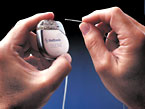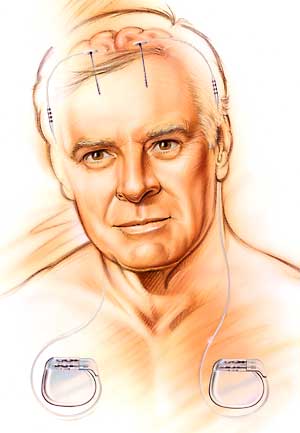


Neurology research
Deep brain stimulation offers relief from symptoms of Parkinson’s disease

The neurostimulator

Deep brain stimulation of the subthalamic nucleus provides good symptomatic relief with much lower doses of medication, reducing the side effects.
![]()
PEOPLE WITH PARKINSON’S DISEASE now have another option for alleviating the disorder’s debilitating symptoms.
Neurological surgeons here are using a new method of deep brain stimulation—a procedure that delivers continuous, high-frequency electrical impulses to the brain—to disrupt the signals that cause some of Parkinson’s most aggravating symptoms, including tremor, slowness of movement, stiffness and difficulty walking.
Previously used in the brain’s thalamus to control tremor, the new bilateral usage of deep brain stimulation targets the subthalamic nucleus, one of the regions of the brain that controls movement and that is overly active in persons with Parkinson’s disease. The new procedure, approved by the Food and Drug Administration (FDA) early this year, has proved successful in relieving not only tremor, but also the other symptoms of the disorder.
"This may be one of the best treatment options for selected patients with advanced Parkinson’s disease," says Fredy J. Revilla, MD, a neurologist at the university’s Movement Disorder Center. He notes that those patients who have undergone the procedure have shown dramatic improvement, but cautions that not all patients are good candidates for the surgery.
Joshua L. Dowling, MD, assistant professor of neurological surgery, and Keith M. Rich, MD, associate professor of neurological surgery, already have implanted the device in about 100 patients at Barnes-Jewish Hospital who have Parkinson’s and other forms of tremor. Their hope is that this new surgical option will become more accessible to patients and that insurance companies will more readily pay for the procedure now that it has gained FDA approval.

Bilateral deep brain stimulation delivers mild electrical current to precisely targeted areas on each side of the brain, relieving the disabling motor symptoms of Parkinson’s disease. Neurostimulators, like those pictured above, are implanted near the collarbone and generate electric signals that are delivered to the brain via thin, coiled wires with electrodes attached at their tips.
"We’ve had remarkable success using this procedure in Parkinson’s patients," says Dowling. "Many return to a relatively normal, active life, usually with a significant reduction in their medication."
Drugs help to "unfreeze" the muscular system, but often cause frequent, exaggerated, involuntary movements, limiting their functional benefit. Deep brain stimulation of the subthalamic nucleus provides good symptomatic relief with much lower doses of medication, reducing the side effects.
The device can be turned on and off or removed if necessary, and stimulation levels are adjusted according to individual needs.
In addition to its clinical uses, the deep brain stimulator
provides a unique way to study the underlying cause and manifestation
of Parkinson’s disease. Researchers at the School of Medicine are
combining imaging techniques with deep brain stimulation to find out more
about the disease. ![]()
![]()